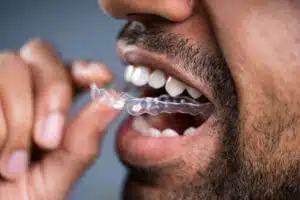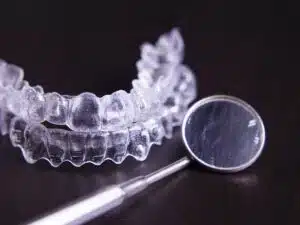Choosing the right orthodontic treatment is important, especially for those with missing teeth. Many people wonder if Invisalign for dentures is a possible solution. Can clear aligners straighten teeth when partial dentures are involved? The answer depends on several factors, including the number of natural teeth remaining and the type of dentures used. Understanding how these treatments work together can help patients decide if Invisalign in Renton is a good option for them.
Understanding Invisalign and Partial Dentures
What Is Invisalign?

Invisalign is a system of clear, removable aligners designed to straighten teeth over time. Unlike metal braces, these aligners are nearly invisible and can be taken out while eating or brushing. Treatment is personalized based on each patient’s dental structure, with new aligners provided every few weeks to guide teeth into place.
What Are Partial Dentures?
Partial dentures are used to replace missing teeth while preserving the remaining natural ones. They help restore function and improve appearance. These dentures can be:
- Removable: Can be taken out for cleaning and sleeping.
- Fixed: Attached permanently using dental implants or crowns.
Can Invisalign Work with Partial Dentures?
The success of Invisalign depends on the presence of enough natural teeth to support movement. Clear aligners work by applying gentle pressure to shift teeth, which means they need stable anchor points. If a person has a few strong natural teeth, Invisalign may still be an option. However, the type of denture plays a role in treatment:
- Removable partial dentures: May need to be taken out while wearing aligners.
- Fixed partial dentures: Can often stay in place throughout Invisalign treatment.
Each case is different, so a professional evaluation is necessary to determine if Invisalign for dentures is a good fit. Factors like gum health, bone structure, and the number of missing teeth all play a role in deciding the best approach.
Factors That Influence Treatment Compatibility
Not everyone with partial dentures can use Invisalign. Several factors determine if the treatment will work effectively. The number of natural teeth, the type of denture, and overall oral health all impact the outcome.
1. The Number of Natural Teeth Left
Invisalign relies on natural teeth to provide the necessary pressure for movement. If too many teeth are missing, the aligners won’t have enough support to work properly. Patients with a few stable natural teeth may still qualify, but an orthodontist will need to assess their suitability.
2. The Type of Partial Denture Used
- Removable Partial Dentures: These may need to be taken out when wearing aligners. If the dentures fill large gaps, Invisalign might not be a practical solution.
- Fixed Partial Dentures: Since they are permanently secured, they can sometimes be incorporated into treatment. However, they won’t shift like natural teeth, which may limit movement in some areas.
3. Bone and Gum Health
Healthy gums and strong bone structure are important for any orthodontic treatment. If bone loss has occurred due to missing teeth, Invisalign may not be as effective. Gum disease or weak bone density could also affect how well the teeth respond to aligners.
4. Orthodontist’s Assessment
Every case is different. An orthodontist will need to examine the alignment of existing teeth, the condition of the dentures, and overall oral health. In some cases, alternative treatments may be recommended. A thorough evaluation helps determine if Invisalign for dentures is the right choice.
Benefits of Using Invisalign with Partial Dentures
For those who qualify, combining Invisalign with partial dentures can offer several advantages. Beyond straightening teeth, this treatment can improve overall dental function and aesthetics.
1. Preserving the Health of Remaining Natural Teeth
Misaligned teeth can lead to uneven pressure on the bite, which may cause excessive wear or discomfort. Invisalign helps distribute biting forces more evenly, reducing the risk of damage to natural teeth.
2. Improving Bite Alignment for Better Functionality
A misaligned bite can make chewing difficult and cause jaw discomfort. Straightening teeth with Invisalign can enhance the way upper and lower teeth come together, leading to a more comfortable and efficient bite.
3. Enhancing Aesthetics for a More Natural Smile
Crooked or gapped teeth can affect confidence. Invisalign can improve alignment, making the smile look more balanced while still accommodating partial dentures.
4. Custom Treatment Plans for Individual Needs
Orthodontists can adjust Invisalign treatment based on the number of natural teeth remaining and the type of denture used. With the right approach, aligners can work alongside dentures to achieve a straighter, more functional smile.
For many patients, Invisalign for dentures provides a way to improve their smile without major disruptions. However, certain challenges should be considered before beginning treatment.
Challenges and Limitations
While Invisalign can work with partial dentures in some cases, it’s not always the best option. Several factors may affect treatment success, making it important to understand potential challenges before starting.
1. Not Suitable for Those with Extensive Tooth Loss
Invisalign depends on natural teeth to shift alignment. If too many teeth are missing, there may not be enough support for the aligners to work effectively. Patients with significant tooth loss may need alternative treatments, such as dental implants or traditional braces.
2. May Require Adjustments to Partial Dentures
For those with removable dentures, wearing both aligners and dentures could feel uncomfortable. Some adjustments may be needed to ensure a proper fit. Fixed dentures, on the other hand, won’t move with the rest of the teeth, which could limit how much alignment can be achieved.
3. Treatment Time Might Vary Depending on Tooth Stability
Teeth that are weakened due to past extractions or gum issues may move at a slower rate than expected. This could extend the length of Invisalign treatment. Patients with compromised tooth stability may need additional monitoring to ensure progress is on track.
4. Requires Regular Dental Visits for Monitoring
Because Invisalign and partial dentures interact in unique ways, frequent check-ups are necessary. Orthodontists will need to assess how well the aligners are working and make any necessary adjustments. Skipping appointments could slow progress or cause complications.
For those considering Invisalign for dentures, weighing these challenges against the benefits is essential. An orthodontist can help determine if the treatment will provide the desired results.

